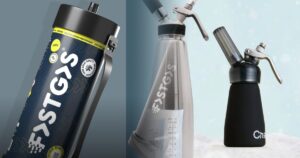N2O Tanks vs. CO2 Cylinders – What’s the Difference?
FastGas Blog
In the world of compressed gases, two common options for various applications are N2O (nitrous oxide) tanks and CO2 (carbon dioxide) cylinders. While these pressurized containers might seem similar at first glance, they have distinct characteristics, applications, and uses.
In this blog post, we’ll explore the key differences between N2O tanks and CO2 cylinders, shedding light on their unique properties and shining a spotlight on our own brand, FastGas because, well, we’re awesome at what we do!
Understanding N2O Tanks
N2O tanks, also known as nitrous oxide tanks, are cylindrical containers designed to store and transport nitrous oxide gas. Nitrous oxide is a colourless and odourless gas composed of two nitrogen atoms and one oxygen atom (N2O). It has various applications across several industries, including medicine, automotive, and culinary arts.
Characteristics of N2O Tanks:
Gas Contents
N2O tanks are filled with nitrous oxide gas, which is commonly used as an anaesthetic in medical procedures, as a performance-enhancing agent in motorsports, and as a propellant in aerosol cans. In culinary applications, it’s used for whipping cream and creating foams.
Cylinder Colour
N2O tanks are typically blue or silver in colour, making them easily distinguishable from other gas cylinders.
Valve Type
These tanks are equipped with specialized valves that allow for precise control and release of the nitrous oxide gas.
Applications
N2O tanks are primarily used in the medical field for anaesthesia, in the automotive industry for nitrous oxide boost systems, and in the culinary world for whipping cream and creating aerated dessert toppings.
Safety Precautions
Handling and storing N2O tanks requires adherence to safety protocols due to the potential risks associated with the gas. Proper ventilation and storage conditions are essential.
Understanding CO2 Cylinders
CO2 cylinders, or carbon dioxide cylinders, are pressurized containers designed to store and transport carbon dioxide gas. Carbon dioxide is a naturally occurring gas composed of one carbon atom and two oxygen atoms (CO2). It has a wide range of industrial, commercial, and recreational applications.
Characteristics of CO2 Cylinders:
Gas Contents
CO2 cylinders contain carbon dioxide gas, which is widely used for carbonating beverages, as a fire suppression agent, for welding and cooling applications, and in the food industry for packaging and preservation.
Cylinder Color
CO2 cylinders are typically silver or aluminium, and they are sometimes distinguishable by their shoulder design.
Valve Type
CO2 cylinders feature various types of valves, including CGA 320 and CGA 580 valves, depending on their intended use.
Applications
CO2 cylinders find extensive use in carbonation systems for beverages, fire extinguishers, industrial welding, aquariums, and more.
Safety Precautions
Proper handling and storage of CO2 cylinders are essential to prevent leaks and potential hazards. Safety measures include securing cylinders, avoiding exposure to high temperatures, and ensuring proper ventilation.
Key Differences between N2O Tanks and CO2 Cylinders
Now that we have an understanding of the basic characteristics of N2O tanks and CO2 cylinders, let’s delve into the key differences between these two types of pressurized containers:
- Gas Type: The most fundamental difference lies in the type of gas they contain. N2O tanks store nitrous oxide gas (N2O), while CO2 cylinders contain carbon dioxide gas (CO2).
- Applications: N2O tanks are primarily used in medical, automotive, and culinary applications, with a focus on anaesthesia, nitrous oxide boost systems, and whipped cream production. In contrast, CO2 cylinders have a broader range of applications, including carbonating beverages, fire suppression, welding, and industrial processes.
- Cylinder Color: While this may not be a decisive factor, N2O tanks are often blue or silver, whereas CO2 cylinders are typically silver or aluminium.
- Valve Type: N2O tanks and CO2 cylinders may have different valve types, which are specific to their intended applications. N2O tanks may feature specialized valves for medical and culinary use, whereas CO2 cylinders use valves suitable for industrial, beverage, or fire suppression applications.
- Safety Considerations: Both N2O tanks and CO2 cylinders require careful handling and storage, but the safety protocols and precautions may vary based on their applications. For instance, N2O tanks used in medical settings must adhere to strict safety and sterilization standards.
- Regulation and Certification: The manufacturing, certification, and regulation of N2O tanks and CO2 cylinders may vary by region and application. In some cases, certain uses of these gases may require compliance with specific industry standards and certifications.
FastGas: A Reliable Source for Compressed Gases
We are a reputable brand known for providing a wide range of compressed gases, including N2O and CO2. Whether you require gas for medical, culinary, industrial, or recreational purposes, FastGas offers high-quality products and reliable services. Here are some key points about our brand:
- Product Diversity: FastGas offers a diverse range of compressed gases to cater to various industries and applications. Our product selection includes medical gases, food-grade gases, industrial gases, and more.
- Quality Assurance: The brand is committed to delivering gases that meet stringent quality standards. We prioritize safety and ensure that our products are manufactured and stored under controlled conditions.
- Expertise: With years of experience in the compressed gas industry, FastGas has the expertise to assist customers in choosing the right gases and equipment for their specific needs.
- Delivery Services: FastGas provides convenient delivery options, ensuring that customers receive their compressed gases promptly and safely.
Conclusion
N2O tanks and CO2 cylinders serve distinct purposes in various industries and applications. While N2O tanks are primarily used for medical, automotive, and culinary purposes, CO2 cylinders have a broader range of uses, including carbonating beverages, welding, and fire suppression. Both types of pressurized containers require responsible handling and adherence to safety protocols.
FastGas stands as a reliable source of compressed gases, offering high-quality products and services to meet the diverse needs of customers across different sectors. Whether you require N2O or CO2, choosing a reputable brand like FastGas ensures that you have access to safe and reliable compressed gases for your specific applications.







